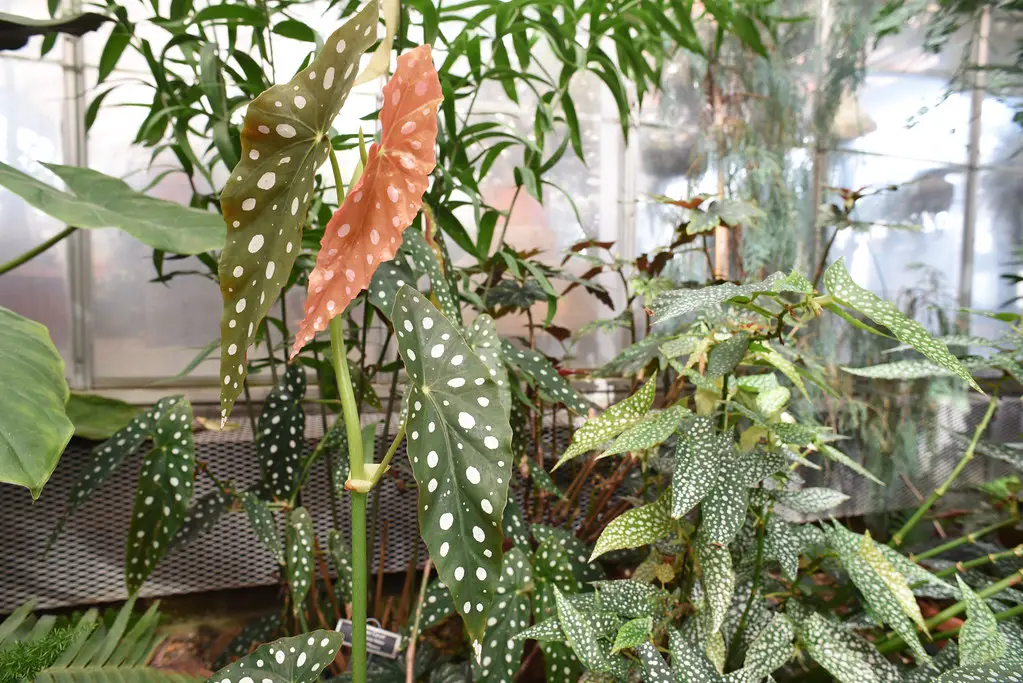The Polka Dot Begonia, scientifically known as Begonia maculata, is a strikingly attractive houseplant renowned for its distinctive spotted leaves. It belongs to the Begonia family, which includes over 1,800 different plant species. With its spotted, wing-shaped foliage and delicate white flowers, the Polka Dot Begonia adds a unique touch to any indoor space.
Native to the tropical rainforests of Brazil, the Polka Dot Begonia thrives in humid environments. Its common name is derived from the silver or white spots that adorn its dark green leaves, giving the plant a dramatic appearance. In addition to being a popular ornamental plant, it has cultural and symbolic significance in various traditions.
Despite its exotic appearance, the Polka Dot Begonia is relatively easy to care for. Its adaptability to different light and soil conditions makes it an appealing option for plant enthusiasts of all levels. Its visually pleasing aesthetic, combined with its manageable care routine, has contributed to its popularity in modern interior design.
| Aspect | Details |
|---|---|
| Common Names | Polka Dot Begonia, Spotted Begonia |
| Botanical Name | Begonia maculata |
| Family | Begoniaceae |
| Plant Type | Perennial |
| Mature Size | 1-2 feet tall |
| Sun Exposure | Partial Shade |
| Soil Type | Well-drained, Rich, Loamy |
| Hardiness Zones | 10-11 |
| Native Area | Brazil |
Polka Dot Begonia Care
Caring for the Polka Dot Begonia is a gratifying experience as the plant responds well to attention and care. Proper light, soil, and water conditions are vital, as is maintaining the right level of humidity.
The Polka Dot Begonia appreciates consistency in its care routine. Though it can adapt to varying conditions, sudden changes in temperature or lighting can cause stress. Regular monitoring and adjustments to its environment will keep the plant healthy and thriving.
Light Requirement for Polka Dot Begonia
The Polka Dot Begonia prefers bright, indirect light. Exposure to direct sunlight can cause the leaves to scorch, while too little light may lead to leggy growth. Finding a spot near a north or east-facing window is often ideal.
Soil Requirements for Polka Dot Begonia
Well-draining, rich, loamy soil works best for the Polka Dot Begonia. The addition of organic matter like compost or peat moss can help maintain soil moisture without causing waterlogging.
Water Requirements for Polka Dot Begonia
Watering should be done when the top inch of soil feels dry. Over-watering can lead to root rot, while under-watering can cause leaf drop. Consistent but moderate watering is key to maintaining a healthy plant.
Temperature and Humidity
The Polka Dot Begonia thrives in temperatures ranging from 65-75°F (18-24°C) and prefers high humidity. A humidifier or a pebble tray with water can help maintain the desired humidity levels.
Fertilizer
A balanced liquid fertilizer can be applied every 4-6 weeks during the growing season. Avoid over-fertilizing as this can cause salt buildup in the soil.
Pruning Polka Dot Begonia
Pruning helps to shape the plant and encourage bushier growth. Removing dead or yellowing leaves and occasional pinching back of the tips will keep the plant looking its best.
Propagating Polka Dot Begonia
The Polka Dot Begonia can be propagated through stem cuttings. Cuttings should be taken just below a leaf node and rooted in water or moist soil.
How To Grow Polka Dot Begonia From Seed
Growing from seed is possible but can be challenging. Seeds should be sown on the surface of moist soil and kept warm and humid until germination.
Common Pests & Plant Diseases
Mealybugs
These can be treated by wiping with alcohol-soaked cotton swabs.
Powdery Mildew
This can be prevented with proper air circulation and controlled humidity.
Common Problems With Polka Dot Begonia
Yellow Leaves
Often a sign of over-watering. Adjust watering schedule and ensure well-drained soil.
Leggy Growth
Typically due to insufficient light. Move to a brighter location or adjust artificial lighting.
Drooping Leaves
May be caused by sudden temperature changes or drafts. Keep in a stable environment.
Pro Tips
- Avoid misting the leaves, as this can lead to mildew problems.
- Rotate the plant regularly to ensure even growth.
- Consider using rainwater or distilled water to avoid mineral deposits on the leaves.
- Be patient with growth, especially if propagating from seed, as Polka Dot Begonia grows slowly.
- Place in a well-lit bathroom to mimic its native humid environment.




